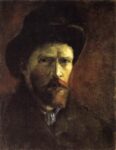
Vincent Van Gogh
Dutch, 1853-1890
Marsh with Water Lilies, Etten, 1881
pen and India ink on wove paper with graphite underdrawings
9 1/4 x 12 3/8 in.
Virginia Museum of Fine Arts (VMFA), Richmond, Collection of Mr. and Mrs. Paul Mellon

Self-Portrait with Dark Felt Hat, Spring 1886
“We went on a fair number of excursions together, several times to the heath at Seppe, among other places, and the so-called Passievaart, a huge marsh. There Rappard painted a large study, much of which was good. Incidentally, he made around 10 small sepias, also in the Liesbos. While he was painting I made a pen drawing of another spot in the marsh where many water lilies grow.” – Letter to Theo, June 1881
COMMENTS
Anthon van Rappard arrived in June [1881]. For both Vincent and his parents, the visit of the young gentleman with the noble name crowned the fantasy of a new life. On the day of his arrival, the Van Goghs took their distinguished guest on a long walk to display him to the neighbors. He accompanied them to church on Sunday and sat at the front of the big medieval sanctuary in the side pew reserved for the preacher’s family, where the whole congregation could see him. He received the ultimate imprimatur of family approval when Vincent took him to Prinsenhage to meet the ailing Cent (who was too sick to receive them).
Vincent exulted in his parents’ approbation as much as his new friend’s attentions. “Van Gogh was in very high spirits then,” Jan Kam recalled of Rappard’s visit, “more cheerful than I would ever see him again.” With camp stool and sketchpad in hand, Vincent led his new “fellow traveler” (the same term he applied to Theo) on a tour of all his favorite spots in the countryside around Etten: the deep, mysterious woods of Liesbosch to the east; the “notorious” village of Heike to the south (home to “gypsy-like” refugees and other “riff-raff” where Vincent often recruited models); and the strange swampland, called the Passievaart, to the west.
At various points along the way, in a celebration of artistic fraternity that Vincent would try for the rest of his life to reenact (most memorably in the Yellow House in Arles), the two men set their rickety stools side by side and shared the act of making art.
Once the drawing began, their roles reversed: Rappard led and Vincent followed. The more warmly his parents embraced the handsome young gentleman-artist, the more eagerly Vincent embraced the friend’s genteel art. While still in Brussels, he had admired Rappard’s pencil-and-pen drawings of trees, vistas, and scenic vignettes, calling them “very witty and charming.” He had adopted Rappard’s favorite métier, reed pen and ink, and his characteristic short, quick pen strokes to render the infinite variety of nature’s textures. Indeed, Vincent had come to the Etten heaths partly in imitation of his young companion, who, like many beginning artists, had made sketching trips into the countryside every summer since adolescence.
Once Rappard joined him, Vincent set aside his long obsession with figure drawing and turned his full attention, for the first time, to landscape. Both drew views of the road to Leur, with its rows of stunted pollard willows on either side; both drew the forest’s edge at Liesbosch. Both drew the Passievaart swamp with the town of Seppe on the horizon.
Despite their shared subjects, shared métier, and even shared vantage points, the images that emerged from these joint sessions differed as much as the two men who created them. From the spot they had picked on the edge of the Passievaart, Van Rappard looked across the watery marshland and drew the distant town as an island of heavy pencil shadings floating in the middle of a sheet of white paper barely bigger than a postcard. He suggested the marsh with just a few random pencil strokes of reeds and weeds, and clouds with the lightest grazing of gray. Vincent looked out across the same swampy vista and cast his eyes downward. Pushing the horizon almost to the top of his much larger sheet, he relegated the town to insignificance and fixed his gaze on the teeming water at his feet: a tangled world of reeds, flowers, lily pads, and leaves, each with its own slant or arc, its own shape and shade, its own cross-hatched reflection on the still surface of the sunlit bog. With a manic vehemence not taught in any exercise book, he filled the bottom of the sheet with clusters of dots, random dark spots, floating circles, and meandering lines in an effort to render the bottomless fecundity that he knew so well from the bank of the Grote Beek. He added a bird, a visitor from his childhood, swooping low over the water in search of the life squirming unmistakably beneath the pencil marks.
- Steven Naifeh and Gregory White Smith, Van Gogh: The Life, New York: Random House, 2011, 233-235
SBMA CURATORIAL LABELS
This delicate drawing provides early evidence of Van Gogh’s instinctive affinity for the textural and rhythmic effects of line. It was done outdoors on the vast marshes of Passievaart not far from Etten, where Vincent’s father had taken up a position as a minister in 1875. Vincent’s pen-and-ink drawing compares interestingly to that of his friend Anthon von Rappard, whom Vincent had befriended during his short-lived attendance at the Brussels Academy of Fine Arts, and with whom he may have even worked side-by-side on these drawings. Van Gogh’s high horizon dwarfs the spire of the church tower of the village Seppe in the distance, elongating the foreground and delighting in the feathery marsh reeds and their shimmering reflections, with the paper itself standing for the ovals of the floating water lily leaves. By contrast, van Rappard’s more conventionally picturesque view replicates the forgettable composition of a postcard.
- Through Vincent's Eyes, 2022
